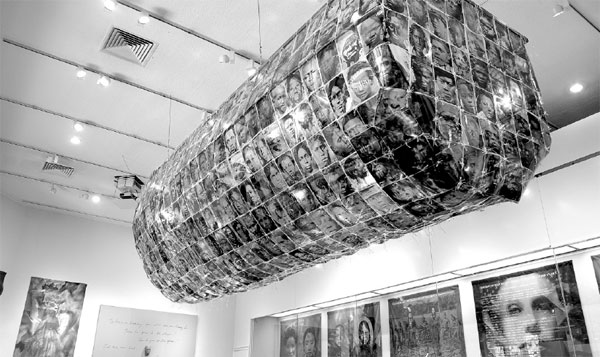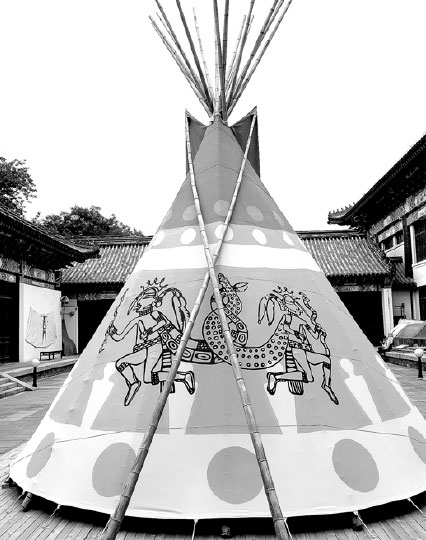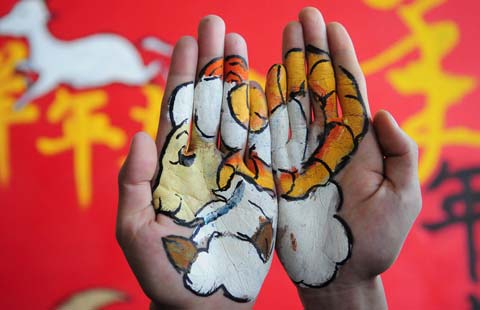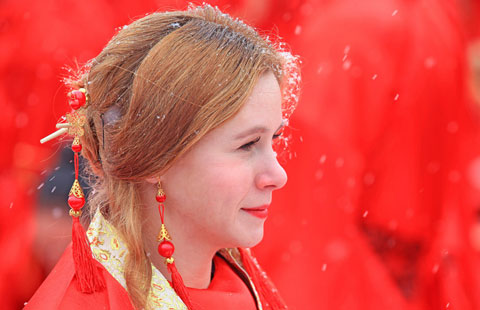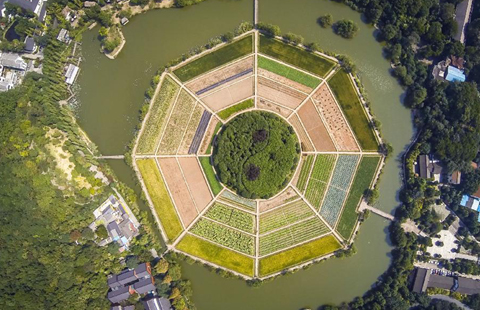Image of identity
Updated: 2015-07-14 07:19
By Lin Qi(China Daily USA)
|
||||||||
An LA artist's show in Beijing explores her multiethnic heritage. Lin Qi reports.
Los Angeles-based multimedia artist Toni Scott presents an anthropological case study of her family history at a solo exhibition in Beijing, entitled DNA - Bloodlines and the Family of Mankind.
She displays three installation pieces and a dozen digital prints inspired by her multiethnic background at the Arthur M. Sackler Museum of Art and Archaeology inside Peking University.
|
Slave Boat, woven with 500 real photos of African-American slaves, is on display at US multimedia artist Toni Scott's solo show in Beijing. Xu Bocheng / For China Daily |
Scott traces her lineage to European immigrants, African slaves and Native Americans. She belongs to a tribal entity called the Muscogee Creek Nation that numbers about 70,000 in the United States.
She set up two installations that resemble tepees to celebrate the cultural richness of the some 500 federally recognized Native American tribes.
Scott drew totems, including warriors and animals worshiped by her tribe, such as jaguars and snakes, on the tepees' exteriors.
"The Muscogee people believed these totems were spiritual guardians, who empowered the citizens and drew away bad things," she says.
Scott also painted suns to represent the cosmos and moons in stages from waxing to waning to symbolize humankind's migrations. She replaced the tepees' wooden poles with bamboo poles as a tribute to the connection between the Asians and their descendants, the Native Americans.
To honor her European and African decent, Scott calls attention to the brutal history of slavery and victims' infinite sadness - a legacy that persists in its impact.
She wove 500 real photos of African-American slaves to form an 8-meter-long boat that's hung from the ceiling in the main exhibition hall. She collected the photos from the US Library of Congress. Some were taken by slave owners to showcase their "fortunes". Others were taken by scientists for research purposes, Scott says.
She colored the images blue to denote the horrors slaves endured during long ocean journeys and the sufferings they experienced after arriving at their destinations.
Scott's exhibition is the third staged under the Dame Jillian Sackler International Artists Exhibition Program. It was established in 2013 by Jillian Sackler, widow of Arthur M. Sackler (1913-87), the US physician, medicine publisher and collector. Sackler masterminded and sponsored the museum's construction.
Every year, the program brings an artist's solo exhibition related to history, society and culture.
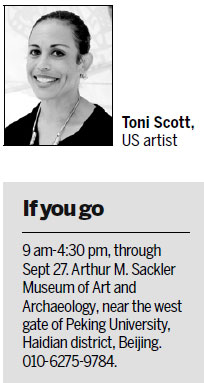
"The program is of educational importance," Jillian Sackler, who presides over the AMS Foundation for the Arts, Sciences and Humanities, tells China Daily.
"It tries to bring very important issues to the contemporary art world. And hopefully the Chinese students can have something meaningful to see, to learn, to disagree or to have some stimulation. I'm not sure how much the viewers, many being students and small children, really know about slavery ... But seeing something visually can have more of an impact than just reading in a book, which one can't quite relate to."
During a trip in China in the early 1980s, Arthur Sackler first expressed an intention to build a museum at a Chinese university like the one he endowed at Harvard.
"He was incredibly interested in art, museums and education. He had made a lot of different collections, ranging from European paintings, American paintings to Native American art. But his largest collection was the Chinese art, which formed the foundation of the Arthur M. Sackler Gallery in Washington DC," Jillian Sackler says.
She pushed forward the museum's completion following her husband's death, shortly after the groundwork was laid at Peking University.
"I felt the museum was, as Arthur said, a bridge between peoples. It was an educational contribution. I wanted to complete it because I knew my husband wanted to."
The museum is designed in a Chinese garden-style befitting Peking University's campus. It has been a retreat for scholars of archaeology and museology, since its official opening in 1993. It hopes to attract more ordinary visitors with dynamic exhibitions.
Contact the writer at linqi@chinadaily.com.cn
|
Toni Scott's installation Tepee, featuring totems of Native American tribes, is to celebrate the cultural richness of the tribes. Xu Bocheng / For China Daily |
(China Daily USA 07/14/2015 page9)

 Japanese war orphans visit graves of adoptive Chinese parents
Japanese war orphans visit graves of adoptive Chinese parents
 Top 10 Chinese provinces with most stock market investors
Top 10 Chinese provinces with most stock market investors
 Lovely 'pearl' on the mountain: Sayram Lake
Lovely 'pearl' on the mountain: Sayram Lake
 Student investment group scores big on stock market
Student investment group scores big on stock market
 Beijing roasts in high temperature
Beijing roasts in high temperature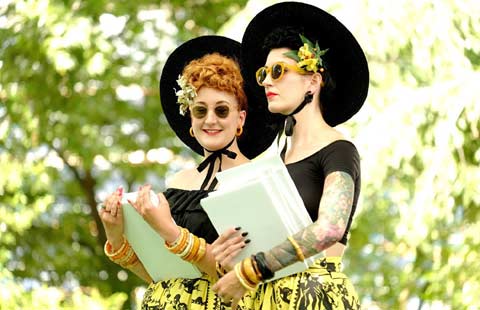
 The world in photos: July 6-12
The world in photos: July 6-12
 Djokovic downs Federer to win third Wimbledon crown
Djokovic downs Federer to win third Wimbledon crown
 Top 10 Chinese companies by profit margin in 2015
Top 10 Chinese companies by profit margin in 2015
Most Viewed
Economy on path of steady growth[1]|chinadaily.com.cn
Gay sex poses HIV threat for youth|Society|chinadaily.com.cn
Japan to release videos of Chinese activists|Asia-Pacific|chinadaily.com.cn
Gay sex blamed for rise in young students with HIV/AIDS|Society|chinadaily.com.cn
More young adults living with parents|Americas|chinadaily.com.cn
Magazine seeks Guangzhou expat families to tour Fujian[1]|chinadaily.com.cn
World's longest sightseeing escalator awaits you in Central China[4]|chinadaily.com.cn
Dai Ethnic Group[1]|chinadaily.com.cn
Minmetals unit offers sponge city solutions for rainfall usage|Business|chinadaily.com.cn
Licenses revoked in anti-porn campaign|Society|chinadaily.com.cn
Editor's Picks

|

|

|

|

|

|
Today's Top News
Pentagon tones down on China threat
Hillary Clinton calls for higher wages for everyday Americans
A day in the life of Muslims during Ramadan in NW China
China's carbon growth rate in decline: report
Mexico: Drug lord 'El Chapo' Guzman escapes, manhunt begins
Lawyers held for 'trying to influence verdicts'
Top court official under inquiry for graft
It is wrong to label illegal immigrants refugees: Opinion
US Weekly

|

|
